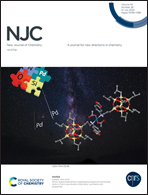Spectral properties of supramolecular systems based on cobalt(ii)/manganese(iii) phthalocyanine and fullero[60]pyrrolidines with PET†
Abstract
Supramolecular systems of the type “donor – π-electron bridge – acceptor” were obtained by self-assembly via a coordination interaction in the (octakis-3,5-di-tert-butylphenoxy)phthalocyaninato)cobalt(II)/(octakis-3,5-di-tert-butylphenoxy)phthalocyaninato)manganese(III) acetate – fullero[60]pyrrolidines systems, in which the metal ion with an unsaturated d-shell plays the role of a π-electron bridge. The chemical structure of the supramolecules (the metallophthalocyanine – pyridyl/imidazole substituted fullero[60]pyrrolidine dyads) was established by using UV, visible, IR, and 1H NMR spectroscopy/mass spectrometry and confirmed by computation; key spectral parameters were obtained. Quantum-chemical calculations (B3LYP*+D3BJ/6-31G) for the studied dyads in the ground and excited states were performed for detecting photoinduced electron transfer (PET) in them. The dependence of the spectral properties on the chemical structure was revealed. The results are relevant for further development of various photovoltaic cells.
![Graphical abstract: Spectral properties of supramolecular systems based on cobalt(ii)/manganese(iii) phthalocyanine and fullero[60]pyrrolidines with PET](/en/Image/Get?imageInfo.ImageType=GA&imageInfo.ImageIdentifier.ManuscriptID=D0NJ02166K&imageInfo.ImageIdentifier.Year=2020)


 Please wait while we load your content...
Please wait while we load your content...